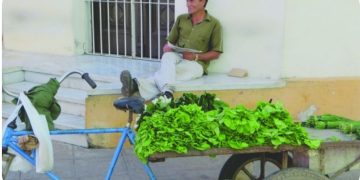The farmers we met in Cuba were all in their 50s and had made career changes, such as transitioning from factory workers or Communist party officials to farmers. Direct-market farmers make some of the best money in the emerging Cuban market economy, and it seems people are drawn to it for financial reasons. Most gardens were cooperative efforts, with three full-time gardeners.
The relationship between these farms and the Cuban government is very interesting. Cuba is slowly emerging from a centrally planned economy. These farms were some of the first private businesses to be allowed in the country. But the state still plays a large role, which the growers generally appreciated.

The farms appeared to have been started on individual initiative, with unused urban lots being cleared during free time, while the growers were still working elsewhere. Once the foundation was there, growers received their initial infrastructure from the state – things such as the concrete raised beds, the soil to fill them (composted dairy manure or sugarcane bagasse) and the irrigation.
The tools and other equipment were not supplied by the state and were extremely old. Though sad, it was fun to see how farmers improvised, and we saw some neat ideas.
Cuba seems to have an extremely helpful Extension program. All growers we met were visited once a week by an agricultural agent, who suggested varieties and supplied organic sprays. On a side note, Cuba has invested heavily in learning about biopesticides and biofertilizers. Growers appreciated the microbial inoculants they were given. In return for the help, the state mandates that each farm sell a certain percentage of its produce to designated consumers at below-market prices: hospitals, new mothers and schools, for example. There were probably other requirements that we did not pick up on.

Growers generally did not seem bothered by the state mandates, seeing them as a fair tradeoff for the help provided, and generally buying in to Cuban society. In some situations, it seemed that the state set the prices the farmer could charge on the open market. One grower resented this and lamented the small amount he made from his days toiling in the sun.
There is a lot of talk in America about creating more local food systems, especially in cities with urban farming. It was very neat in Cuba to see such an urban system for fresh vegetables in the flesh, born not from ideals but rather out of necessity. At each garden, we saw individuals and also wholesalers buying produce; people in bike and donkey carts would fill their carts and then go around the neighborhood selling vegetables at a profit. This local produce system is also promoted by the lack of refrigerated infrastructure – vegetables have to go from field to customer fast at 90 ̊ F!
I do not want to give the impression that all of Cuba’s food is being produced on a small scale – we heard of large, government-owned farms in the countryside that produce the country’s sugar, beans and other staples using conventional methods, and also veggies for the tourists. But from what we saw, the neighborhood gardens supply Cubans with substantial amounts of fresh vegetables.
I hope that I have conveyed an interesting picture of what I saw and heard in Cuba, but in a short column I feel unequal to the task of communicating the general warmth, humor and curiosity of the farmers my brother and I met. They were kind people with no malice toward us as Americans. One grower spoke longingly of our cool northern seasons, lamenting the year-round heat that broils his plants.
“You are so lucky. Farming is much easier for you in America,” he said. “It’s like you get to farm with air conditioning.”
“That’s true,” I told him. “Until the air conditioner turns into a freezer in November.”
We have plenty to learn from each other.
— Sam Hitchcock Tilton, VGN columnist































